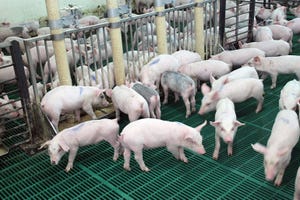Numerous boar studs and sow farms have installed filtration systems to reduce the airborne transmission of porcine reproductive and respiratory (PRRS) virus. Others are considering air filtration systems. Interest in filtering nurseries, grow-finish and wean-to-finish facilities, especially in swine-dense areas, is also growing.
April 18, 2012

Numerous boar studs and sow farms have installed filtration systems to reduce the airborne transmission of porcine reproductive and respiratory (PRRS) virus. Others are considering air filtration systems.
Interest in filtering nurseries, grow-finish and wean-to-finish facilities, especially in swine-dense areas, is also growing.
Filtration Challenges
Each site presents a unique set of challenges to implementing an air filtration system. The challenges include maintaining biosecurity, adequate ventilation and cooling during hot-weather conditions and preventing backdrafting through non-operating fans and unplanned openings during manure pumping, at entry points
and at load-outs.
One of the major obstacles for adding air filtration to hog facilities is the high initial cost. Even though costs can range up to $250/sow, owners of sow farms are considering air filtration as a very viable option because of the huge losses a PRRS outbreak can inflict.
When evaluating a facility for filtration, a number of questions concerning overall effect on ventilation performance need to be addressed, including:
• Does the present ventilation system meet industry standards?
• What types, size, quality and quantity of filters are needed?
• What is the longevity of the filters under these conditions?
• What will happen to overall ventilation system performance when filters are put in place?
• How much will it cost to install a complete filtration system?
The components of an air filtration system include:
• Pre-filters and high-efficiency filters.
• A properly sized and sealed box or filter bank to contain the filters.
• Adequately sized fans, air inlets, cooling system and attic air intake.
• Positive-pressure ventilation for load-out points.
• Positive and/or negative ventilation for entry points.
• Backdraft prevention for non-operating fans.
• Sealed unplanned openings, including pit covers, emergency exit doors, cracks, holes, etc.
• Entry doors and walkways in the attic to service and replace filters.
• A slide covering the opening to the manure surface that reduces back-drafting during manure pumping.
Filter Types, Sizes
Two different types of filters are used: a pre-filter and a high-efficiency, virus-capturing filter. The filter’s ability to capture various particle sizes at varying airflow rates is based on a MERV (minimum efficiency reporting value) rating. Depending on the filter manufacturer, pre-filters are typically MERV-8 and used to capture larger particles, while the PRRS virus-capturing filter will have MERV ratings of 14 to 16, depending on the make and the manufacturer.
The ideal filtration system would use high-efficiency particulate air (HEPA) filters. However, costs associated with this method, and the effect it has on traditional, negative- pressure ventilation systems, make it very difficult to adapt this method of filtration system to large-scale units.
Initially, MERV-16 filters were selected for use in boar studs, where they are still the filter of choice. The first sow units were also filtered with MERV-16 filters. However, using MERV-16 filters requires more square footage of filter area than MERV-14 or 15 filters for a given airflow capacity.
In order to reduce installation costs, several different makes of filters have been tested by Scott Dee, DVM (Pipestone Veterinary Clinic, Pipestone, MN and Andrea Pitkin, DVM, in research conducted at the University of Minnesota in 2008 and by others with varying success. Under the conditions of their study, the following indications were provided:
• Not all MERV-14 to 16 filters are equal in efficacy.
• Modified MERV-14 filters may provide sufficient protection against aerosolized PRRS virus, potentially leading to reduced overall cost and improved ventilation system performance, especially when PRRS virus aerosol survival may be reduced due to weather conditions, such as the heat of summer.
When selecting filters, consider the following:
• Not all filters are alike, no matter what the MERV rating is.
• MERV ratings encourage filter selection based on particle size requirements.
• Inspect filter construction and installation for good sealing and possible damage. No filter can stop particles that bypass the media.
• Evaluate filter effectiveness at low airflow rates.
• Confirm with manometers (instruments that measure pressure) to indicate time for filter change-out and regularly monitor filters for damage.
Careful consideration is necessary when determining the amount of filter area required for an air inlet and endwall or sidewall cool cells. Static pressure created by the pre-filter and high-efficiency filter should be no more than 0.15 in. — preferably less. If the combination of MERV-8 pre-filter and high-efficiency MERV-14 or-15 filters are placed over a ceiling inlet, the flow rate through the filters is typically less than 150 cu. ft./min. (cfm) per sq. ft. of filter.
For cool cells where airflow goes directly into the room (not through the wall inlets), the maximum flow rates may range between 175 cfm to 200 cfm per sq. ft. of filter. A rule of thumb for cool cells is to provide 2 sq. ft. of filter per 1 sq. ft. of cool cell. Flow rates at different static pressures vary somewhat between manufacturers.
Getting enough airflow to a 1,200-cfm ceiling air inlet would require two, 24 in. x 24-in. MERV-14 or 15 filters to achieve approximately 1,000 to 1,200 cfm of airflow. A 2,000-cfm ceiling inlet requires 14.7 sq. ft. of filter area (two, 24 in. x 24 in. and two, 20 in. x 24-in. filter assemblies). A 3,000 to 4,000 cfm ceiling inlet will require approximately 22 sq. ft. of filter area with MERV-14 or-15 filters. It is important to remember that inlet airflow capacity is typically based on static pressures of 0.10 in.
Filter Longevity
The use of pre-filters and low-operating airflows has extended the life of the more expensive MERV-14 to-16 filters. Currently, the initially installed, high-efficiency filters have been in place for more than five years. The pre-filters are changed out approximately every six months. It is recommended that static pressures be monitored to indicate when the filters are plugged, resulting in reduced ventilation performance.
Filters also need to be periodically inspected for rodent damage or if the filter media is deteriorating. Inspect filter installations for good sealing.
Ventilation System Assessment
Key factors when evaluating a ventilation system include air distribution patterns, ventilation fan location, air exchange rates and requirements per animal, attic air intake, pit transitions and annexes, fan staging and controller knowledge and supplemental cooling. Figure 1 shows a typical cross-section of a breeding/gestation barn with filtered ceiling inlets.

It is important to keep in mind that the addition of filtration will hinder overall ventilation performance. Common problem areas include insufficient fan capacity (less than 250 cfm/sow in breeding/gestation; 600 cfm/sow in farrowing) for hot weather conditions, not enough eave attic air intake capacity, leaking pit covers and not enough ceiling inlets.
Ventilation fans will run at higher static pressure rates during hot weather, when all fans are required. For typical ventilation fans used in swine operations, maximum static pressure should be around 0.20 in. Various static pressure points in a well-designed, filtered swine facility include:
• Attic air intake — less than 0.04 in.
• Air inlet — 0.04 to 0.08 in.
•Fan pit transitions — less than 0.05 in.
• Filters: Pre-filter — less than 0.03 in.; MERV-14 to-16 filter — less than 0.12 in.; combination of pre-filter and high-efficiency filter — less than 0.15 in.
• Cool cells — less than 0.04 in.
Note: Static pressures are additive. [air intake (0.03) + filters (0.12) + air inlet (0.05) = 0.20 in. of static pressure that a wall fan creates].
Fan performance can drop off considerably when operated at static pressures greater than 0.20 in. This is especially true for some larger diameter fans. Bioenvironmental and Structural Systems Laboratory (BESS) has established an airflow ratio (airflow at 0.2 in. static pressure divided by airflow at 0.05 in. static pressure) for most agricultural ventilation fans.
For example, airflow ratios for tested 50- to 52-in., single-phase fans ranged from a low of 0.09 to a high of 0.87. The higher the airflow ratio, the better the performance of the fan as static pressure increases. These fans should be seriously considered for new construction if filtration is to be used. For existing facilities, the ratio will provide a guide on whether or not fans should be replaced or more fans added when a facility is filtered.
As with many swine facilities with interior ceiling air inlets, a commonly overlooked factor is the attic air intake. Attic air intake area should be sized for a maximum of 400 cfm/sq. ft. of air intake. Transitions and openings to pit annexes for pit fans should be sized for a maximum of 800 cfm/sq. ft. of cross-sectional area. Fan staging and moving into tunnel ventilation mode sooner will need to be addressed.
With the potential decrease in ceiling inlet airflow due to increases in static pressure, inside building temperatures could increase faster when outdoor temperatures are cooler. This will cause the system to go into tunnel mode at lower outdoor temperatures and could chill the sows located next to the tunnel openings.
Using air filtration with negative- pressure systems makes the sealing of all air leaks in a building a high priority. These areas include fans not in use, cracks, pit annexes, doors, entry or exit points or any other unplanned openings.
Minimizing backdrafting through shutters of non-operating fans is currently being handled with double shutters, chutes or wind socks covering the front of fans. Test results from BESS labs and PRRS virus testing by Scott Dee, DVM, have shown preliminary, positive results for these technologies. But further testing and field observations are needed.
One of the main issues with loading chutes is performance during high-wind conditions. Load-out and load-in areas have been handled with positive-pressure fans (typically two, 24-in., 7,000-cfm fans) forcing air out the load-out door opening. Makeup air is pulled from the filtered sections of the unit. Entryways are positively and/or negatively ventilated when doors are opened and purged after doors are closed, typically for two minutes.
Field Experiences
Filtration systems were designed for four, 200- to 250-head boar studs. The goal for designing these systems was to reduce the possibilities of aerosol transmission of PRRS virus and infection of animals housed in these facilities. The filtration systems were set up to filter all incoming air during cold, mild and hot weather conditions using MERV-8 prefilters and Merv-16 filters. Objectives of the projects were to:
• Filter all incoming air through the air inlets and cool cells, if applicable.
• Provide adequate ventilation.
• Provide a minimum of 250 cfm of airflow per boar.
• Maintain boar comfort and productivity.
• Maintain worker comfort and productivity.
• Seal all unplanned openings.
• Minimize costs.
Problems to overcome included:
• The impact of high static pressures created by the filters on fan performance.
• Installed ceiling air inlets were not compatible with a full mechanical ventilation system.
• Existing fans did not provide enough airflow with the higher static pressures.
• Sealing all unplanned openings, including non-operating fans and pit covers.
• Filtration box construction and installation.
• Hot-weather cooling.
Air inlet filtration for the boar studs was accomplished by installing two Camfil Farr 1511-MV16 24 in. x 24 in. filters on each 1,200-cfm ceiling air inlet.
At 600 cfm per filter, the pressure resistance was approximately 0.2 in.; at 480 cfm the pressure resistance was approximately 0.125 in. In order to extend the life of the MERV-16 filter, a pre-filter was recommended. At 480 cfm per 24 in. x 24 in. pre-filter (Camfil-Farr 2-in.-deep Aeropleat IV, MERV-8), the pressure resistance from the 2-in.- deep pre-filter is minimal and is recommended over the 1-in. pre-filter.
It should be noted that when the change to MERV-14 or-15 filters was made, the increased airflow through the filters also increased the airflow and pressure resistance through the pre-filters slightly and needed to be accounted for.
Since the boar studs were originally designed as curtain-sided, cross-ventilated facilities during warm and hot weather conditions, installed fan capacity was limited to cold and mild and a portion of the warm weather ventilation. Both studs needed additional fans. Some of the existing fans needed to be replaced because of poor airflow output at static pressures greater than 0.20 in. Additional fans selected for the projects included 24- and 36-in. units. These fans had an airflow ratio (airflow at 0.2 in. divided by airflow 0.05 in. of static pressure) of 0.89.
After the filtration system was installed and additional fans added, the ventilation rate per boar was approximately 220 cfm. Even though a ventilation rate of 250 cfm per boar was not achieved, the high-pressure atomizer cooling system that was added keeps the stud at satisfactory temperatures during hot weather.
Breeding Barn Example
A 120-ft.-wide breeding barn with 1,536 gestation stalls, 72, 2700-cfm inlets, 8-24-in. pit fans, 16-50-in. wall fans and 1,152 sq. ft. of cool cell area were filtered. At 0.10 in. of static pressure, approximately 284 cfm/sow was being delivered by the ventilation system without filtration. Adding filtration reduced overall capacity to less than 250 cfm/sow. However, with cool cells, this ventilation rate was considered adequate. The effect of static pressure on fan performance is shown in Table 1.
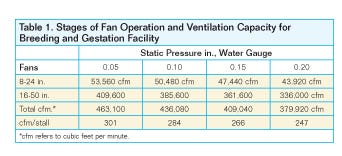
Each 2,700-cfm ceiling air inlet had a combined filter area of 14.7 sq. ft. or a combination of two, 24-in. x 24-in. and two, 20-in. x 24-in. filter assemblies. At 150 cfm/sq. ft. of filter, one could expect about 2,200 cfm of airflow per inlet. The total area of the cool cell was 1,152 sq. ft. (two, 6 x 40-ft. and two, 6 x 56-ft. cool cells on the endwall).
At 250 cfm/sow, the overall hot weather ventilation should be 384,000 cfm. Given the area of the cool cells (1,152 sq. ft.), the flow rate through each sq. ft. of cool cell was approximately 336 cfm. The rate of 384,000 cfm required approximately 2,200 sq. ft. of filter area or 550, 2 x 2-ft. filtered assemblies. This required a sizable filter bank area to cover the cool cell endwalls and sidewalls. An 8-ft-high filter bank with a 4-ft.-wide filter strip in between the trusses covered the filter area required for the endwall cool cell (Figure 2). Cross section of filtering sidewall cool cells is depicted in Figure 3.
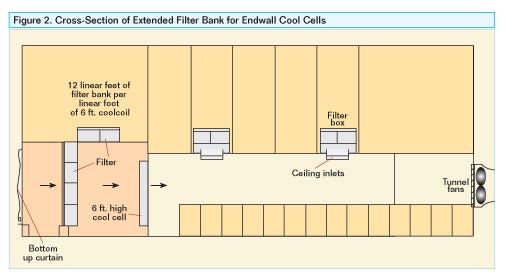
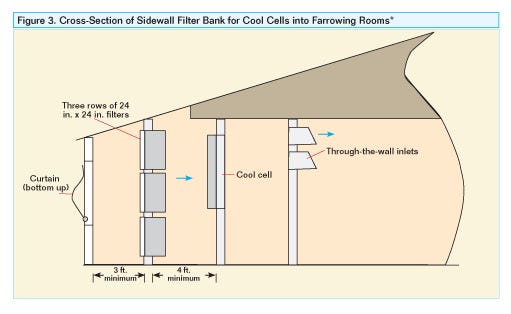
New Farrowing Room
Overall, the ventilation system in the 30-crate farrowing rooms appeared to be very adequate with an overall ventilation rate of 689 cfm/sow at 0.10 in. of pressure, as shown in Table 2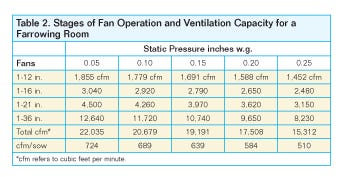 .
.
Each room had 15, 1,400-cfm inlets for an overall capacity of 21,000 cfm, which matches up with fans at 0.10 in. of pressure. Having two, 24 x 24-in. filtered assemblies over each inlet would reduce the static pressure and increase the ventilation rate to approximately 600 cfm/sow.
With the sidewall cool cells annexed to allow for airflow directly into the attic, the 500-cfm/sow rate was considered adequate.
Filtration Costs
Total cost for a 3,000-sow facility came to $633,000 for the gestation barn and farrowing rooms. All incoming air was brought in through filtered ceiling inlets.
This project required 3,776 pre-filters and MERV-16 filters. Additional costs for new shutters, perimeter fence, 21 doors with magnetic sensors, and 16 video cameras came to $88,000.
To properly seal up everything in the unit required 100 cases of caulk costing $18,000 and the labor of four men working two weeks.
Cost estimates for a large commercial sow herd to completely filter facilities typically range from $175 to $250/gestation stall with complete filtration. This cost assumes that all incoming air through the inlets and/or cool cells will be filtered through MERV-14 or-15 filters and a pre-filter.
With tunnel-ventilated facilities, the cost of filtration increases because the airflow through the filtered ceiling inlets has to be accounted for in the filtered bank for the cool cells.
New Construction
New construction and filtering will depend on how the unit is cooled during hot-weather operation. If cool cells are employed, provisions should be made to introduce the air coming from the cells directly into the attic space and solely filtering the ceiling inlets and eliminating tunnel ventilation.
The issue with long barns is always the fire-draft stops in the attic space. If the trusses were properly designed to allow for adequate airflow over the sidewall plate line, cool cells could be installed along the sidewall and isolated from the interior of the barn. If all of the incoming air is brought through ceiling inlets in the gestation barn, baffled inlets over head-to-head stalls should be installed.
Other options besides cool cells would be to provide drip cooling for the sows in the farrowing rooms and cool sows directly in the breeding/gestation barn.
It is important to remember that utilizing air filtration systems to reduce the transmission of PRRS is a work in progress. Early adapters of this technology, for the most part, have had positive results. New developments will surely be forthcoming as more research is conducted and existing systems are analyzed.
Applying good design practices, understanding the effects of static pressure on the ventilation system, using high-quality filters and preventing backdrafts will go a long way toward insuring the success of the system.
It is important to remember that a filtration system has to be implemented with a solid, adhered-to biosecurity plan.
You May Also Like

